|
|
Updated as per James P. Tuttle's The Hawk Moths of North America, June 29, 2010
Updated as per Butterflies and Moths of North America website, June 29, 2010
Updated as per personal communication with Manyee Desandies (Smerinthus cerisyi, Manduca sexta); June 28, 2010
Updated as per personal communication with Grace Munakata (Manduca sexta, Berkeley): August 6, 2011
Updated as per personal communication with Lynn Fields (Hyles lineata, Castro Valley, May 22, 2012); September 5, 2013
|
Sphingidae Larval Checklist
Alameda County, California
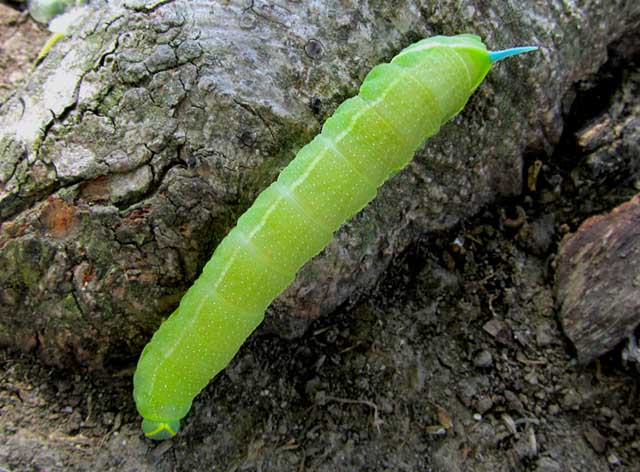
Smerinthus ophthalmica, Newark, Alameda County, California,
courtesy of Manyee Desandies.
For care of "found larvae/caterpillars" visit Manduca sexta larva, central Texas, August 21, 2008, Trina Woodall.
This page is inspired by and dedicated to Manyee Desandies.
On June 29, 2010, Manyee writes, "Can you please help me with the ID of this caterpillar?"
Manyee was referring to the beautiful image of the Smerinthus cerisyi larva, depicted at the top of this page.
Manyee also provides the beautiful images of Manduca sexta below.
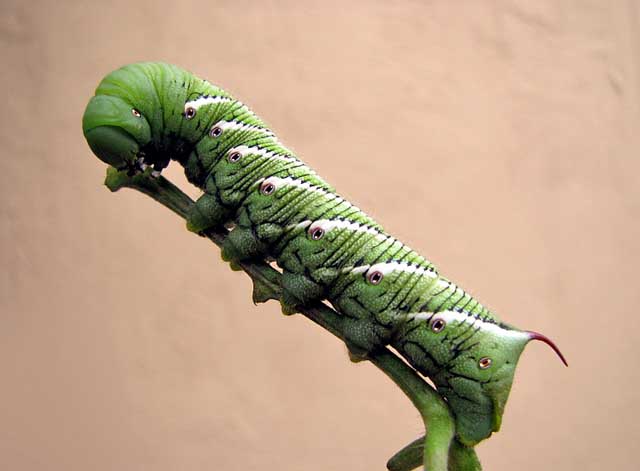
Manduca sexta fifth instar, Newark, Alameda County, California,
September 22, 2007, courtesy of Manyee Desandies.
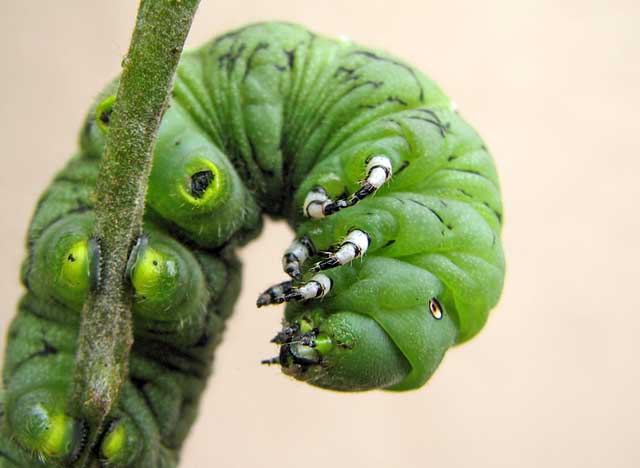
Manduca sexta fifth instar, Newark, Alameda County, California,
September 22, 2007, courtesy of Manyee Desandies.
Please visit Grace Munakata's images of Manduca sexta
larvae devouring tomato foliage and excavating tunnels in soft earth.
Many thanks to Lynn Fields who sends the following image of Hyles lineata from Castro Valley.
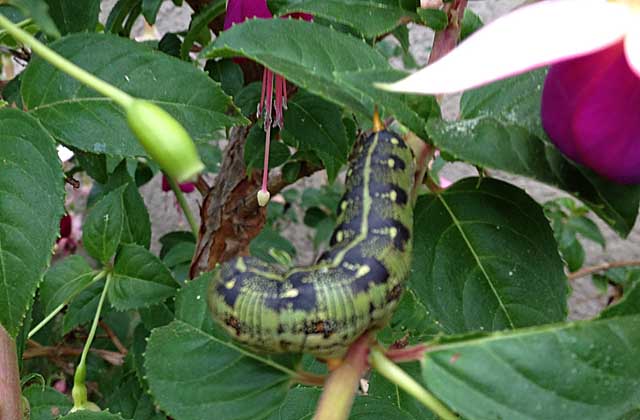
Hyles lineata final instar, Castro Valley, Alameda County, California,
May 22, 2012, Lynn Fields.
Thirty-two Sphingidae species are listed in the USGS for California. Not all of the species are reported by USGS or are anticipated in Alameda County.
It is hoped that this checklist, with the thumbnails and notes, will help you quickly identify the Sphingidae larvae you have encountered.
A WO" after the species name indicates that I have no confirmed reports of this species in Alameda County, but I
(William Oehlke) expect that this moth is present.
A USGS indicates the moth is reported on the USGS website and/or in Moths of Western
North America, #2. Distribution of Sphingidae of Western North America, revised, an excellent little booklet available through Paul Opler.
Please help me develop this list with improved, documented accuracy by sending sightings (species, date, location), preferably with an
image, via email to Bill Oehlke.
Please also send your sightings to BAMONA, an excellent on-line resource.
Sphinginae subfamily
Sphingini tribe:

|
Manduca quinquemaculatus WO, Five-spotted Hawkmoth:
Tomato Hornworms: Black horn at end of abdomen.
Potato, tobacco, tomato, other plants in nightshade family (Solanaceae). Very beautiful brown form. See bottom of page.
|
 |
Manduca sexta USGS/MD/GM, Carolina Sphinx:
Tobacco Hornworms, equipped with red-tipped horn at end of abdomen; true gluttons, feed on tobacco, tomato,
occasionally potato, pepper crops, other plants in nightshade family (Solanaceae).
|
Manduca sexta, Newark, September 22, 2007, Manyee Desandies.
Manduca sexta, Berkeley, August 4, 2011, Grace Munakata.
 |
Sphinx chersis
WO, Great Ash Sphinx: Pale bluish green. Head has pair of yellow
lateral bands meeting at apex. Ash, lilac, privet, cherry, quaking aspen.
|
 |
Sphinx drupiferarum
WO, Wild Cherry Sphinx: Larvae hide by day, feed primarily on cherry, plum, apple
at night. Amelanchier nantuckensis in Massachusetts, and Michigan on Prunus serotina. Note purple oblique lines.
|
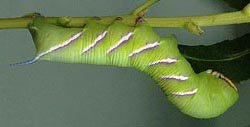 |
Sphinx perelegans
WO, Elegant Sphinx; unique shield on first thoracic segment, same colour as body, forms tight-fitting hood over vertex of head.
hiding pair of glossy black spots on top of head, revealed if animal is disturbed.
|
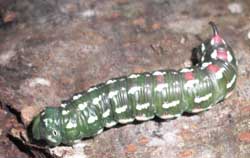 |
Sphinx sequoiae
WO, the
Sequoiae Sphinx:
Larvae feed on California juniper (Juniperus californica) and Rocky Mountain juniper (J. osteosperma).
|
Smerinthini Tribe:
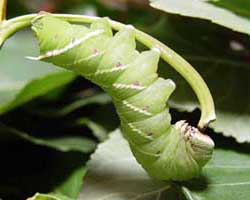 |
Pachysphinx occidentalis
WO,
the Big Poplar Sphinx:
Larvae feed on cottonwood and poplar (Populus) and willow
(Salix).
Larvae are very chunky with little to distinguish them
from Pachysphinx modesta.
|
 |
Smerinthus cerisyi
MD/USGS,
Cerisy's Sphinx;
Pale green, with granular skin, pale lateral diagonal lines, faint red
spiracular circles, very pale longitudinal lines running from
head to more pronounced anal diagonal line. Green heads bounded dorsally with pale yellow inverted V.
|
Macroglossinae subfamily
Dilophonotini Tribe:
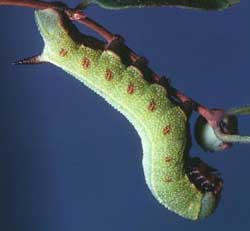 |
Hemaris thetis USGS.
Snowberry (Symphoricarpos), honeysuckle (Lonicera), Coralberry, viburnums, high bush cranberry, hawthorn (Crataegus).
Horn: black with slightly lighter base. Formerly classified as H. diffinis or H. senta. Those species west of Continental Divide now classified as
H. thetis.
|
Philampelini Tribe:
 |
Eumorpha achemon
WO, Achemon Sphinx: Grape (Vitis), Virginia Creeper
(Parthenocissus quinquefolia). other vines, ivies (Ampelopsis).
Larvae occur in both light (green) form and darker (tan/brown) form. Note six "segmented" oblique lines.
|
Macroglossini Tribe:
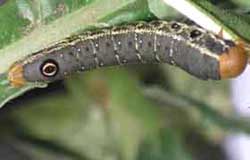 |
Arctonotus lucidus
USGS, Pacific Green
Sphinx Moth or Bear Sphinx: Evening primrose
(Oenothera dentata var. campestris) and clarkias. David Wikle
fed them on both Mexican evening primrose, Oenothera berlandieri
and evening primrose, Oenothera biennis. |
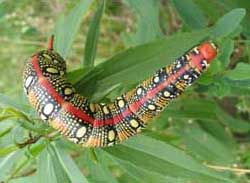 |
Hyles euphorbiae
USGS, Leafy Spurge Hawk Moth
Leafy spurge. Conspicuously colored, with pronounced tail or "horn" near rear end.
Young larvae variously patterned with green, yellow, black;
older larvae: distinctive red, black, yellow, white color
pattern. Mature larvae approach 10 cm in length; when disturbed, regurgitate slimy green liquid.
|
 |
Hyles lineata
USGS/LF, White-lined Sphinx
Larvae are highly varied and feed on a great diversity of plants
including willow weed (Epilobium), four o'clock (Mirabilis),
apple (Malus), evening primrose (Oenothera), elm
(Ulmus), grape (Vitis), tomato (Lycopersicon),
purslane (Portulaca), and Fuschia.
All larvae seem, however, to have the red/black swellings split by
dorso-lateral lines. |
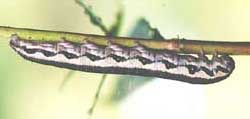 |
Larvae feed on elegant fairyfan (Clarkia unguiculata) in the evening primrose family (Onagraceae). |
|
|
Enjoy some of nature's wonderments, giant silk moth cocoons.
These cocoons are for sale winter and fall. Beautiful Saturniidae moths will emerge the following spring and summer.
Read Actias luna rearing article. Additional online help available.
Use your browser "Back" button to return to the previous page.
This page is brought to you by Bill Oehlke and the
WLSS. Pages are on space rented from Bizland. If you would like to become a "Patron of the Sphingidae Site", contact Bill.
Please send sightings/images to Bill. I will do my best to respond to requests for identification help.
 | 
Show appreciation for this site by clicking on flashing butterfly to the left.
The link will take you to a page with links to many insect sites. |





